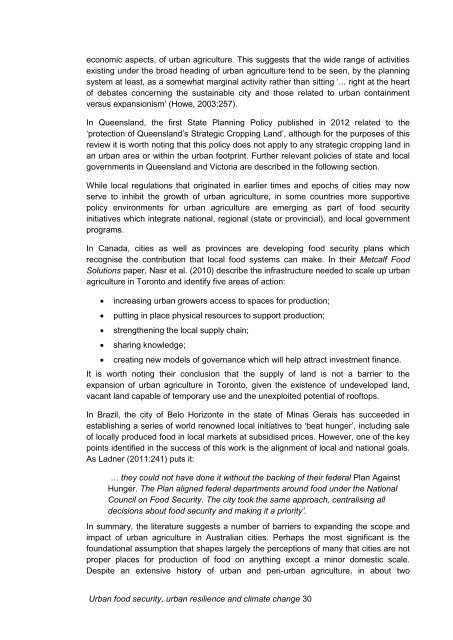Urban food security, urban resilience and climate change - weADAPT
Urban food security, urban resilience and climate change - weADAPT
Urban food security, urban resilience and climate change - weADAPT
Create successful ePaper yourself
Turn your PDF publications into a flip-book with our unique Google optimized e-Paper software.
economic aspects, of <strong>urban</strong> agriculture. This suggests that the wide range of activitiesexisting under the broad heading of <strong>urban</strong> agriculture tend to be seen, by the planningsystem at least, as a somewhat marginal activity rather than sitting ‘... right at the heartof debates concerning the sustainable city <strong>and</strong> those related to <strong>urban</strong> containmentversus expansionism’ (Howe, 2003:257).In Queensl<strong>and</strong>, the first State Planning Policy published in 2012 related to the‘protection of Queensl<strong>and</strong>’s Strategic Cropping L<strong>and</strong>’, although for the purposes of thisreview it is worth noting that this policy does not apply to any strategic cropping l<strong>and</strong> inan <strong>urban</strong> area or within the <strong>urban</strong> footprint. Further relevant policies of state <strong>and</strong> localgovernments in Queensl<strong>and</strong> <strong>and</strong> Victoria are described in the following section.While local regulations that originated in earlier times <strong>and</strong> epochs of cities may nowserve to inhibit the growth of <strong>urban</strong> agriculture, in some countries more supportivepolicy environments for <strong>urban</strong> agriculture are emerging as part of <strong>food</strong> <strong>security</strong>initiatives which integrate national, regional (state or provincial), <strong>and</strong> local governmentprograms.In Canada, cities as well as provinces are developing <strong>food</strong> <strong>security</strong> plans whichrecognise the contribution that local <strong>food</strong> systems can make. In their Metcalf FoodSolutions paper, Nasr et al. (2010) describe the infrastructure needed to scale up <strong>urban</strong>agriculture in Toronto <strong>and</strong> identify five areas of action:increasing <strong>urban</strong> growers access to spaces for production;putting in place physical resources to support production;strengthening the local supply chain;sharing knowledge;creating new models of governance which will help attract investment finance.It is worth noting their conclusion that the supply of l<strong>and</strong> is not a barrier to theexpansion of <strong>urban</strong> agriculture in Toronto, given the existence of undeveloped l<strong>and</strong>,vacant l<strong>and</strong> capable of temporary use <strong>and</strong> the unexploited potential of rooftops.In Brazil, the city of Belo Horizonte in the state of Minas Gerais has succeeded inestablishing a series of world renowned local initiatives to ‘beat hunger’, including saleof locally produced <strong>food</strong> in local markets at subsidised prices. However, one of the keypoints identified in the success of this work is the alignment of local <strong>and</strong> national goals.As Ladner (2011:241) puts it:… they could not have done it without the backing of their federal Plan AgainstHunger. The Plan aligned federal departments around <strong>food</strong> under the NationalCouncil on Food Security. The city took the same approach, centralising alldecisions about <strong>food</strong> <strong>security</strong> <strong>and</strong> making it a priority’.In summary, the literature suggests a number of barriers to exp<strong>and</strong>ing the scope <strong>and</strong>impact of <strong>urban</strong> agriculture in Australian cities. Perhaps the most significant is thefoundational assumption that shapes largely the perceptions of many that cities are notproper places for production of <strong>food</strong> on anything except a minor domestic scale.Despite an extensive history of <strong>urban</strong> <strong>and</strong> peri-<strong>urban</strong> agriculture, in about two<strong>Urban</strong> <strong>food</strong> <strong>security</strong>, <strong>urban</strong> <strong>resilience</strong> <strong>and</strong> <strong>climate</strong> <strong>change</strong> 30
















